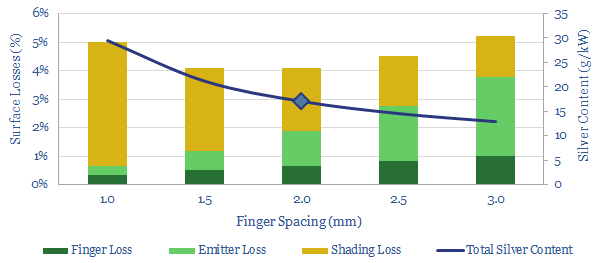This data-file calculates the losses in a solar cell from first principles. Losses on the surface of the cell are typically c4%, due to contact resistance, emitter resistance and shading. Sensitivity analysis suggests there may be future potential to halve silver content in a solar cell from 20g/kW to 10g/kW without materially increasing the losses beyond 4%.
There are three types of surface losses in a solar cell (chart below). Usually, the losses might run to around c4-5%. This is due to resistance in the contact fingers (0.5-1%), resistance in the emitter (1.5-2.5%) and resistance due to shading of the silicon by fingers and busbars (2-3%).

This data-file allows stress-testing of different impacts on solar cell efficiency. You can vary the busbar number (#), busbar spacing (mm), finger length (mm), finger spacing (mm), finger height (μm), finger width (μm), finger resistivity (Ωm), emitter resistivity (Ω/square), open circuit voltage (Voc), current density (mA/mm2). The maths are quite satisfying.
There is no real challenge thrifting silver use in a solar panel by reducing the volume of the contacts. Improved printing techniques may even allow for lower shading losses. More efficient cell designs (e.g., TOPCons) may also allow for slightly higher surface losses.
Lowering silver content from 20 g/kW to 10 g/kW over the next 5-10 years is possible, especially as more efficient new printing technologies are developed. This matters as silver could become a bottleneck in the ascent of solar and face its own challenges in ramping silver mining.
Sensitivity analysis is shown for optimizing finger spacing, narrower fingers, increasing the number of busbars and printing taller-thinner fingers, and how this will all impact losses in a solar cell.
